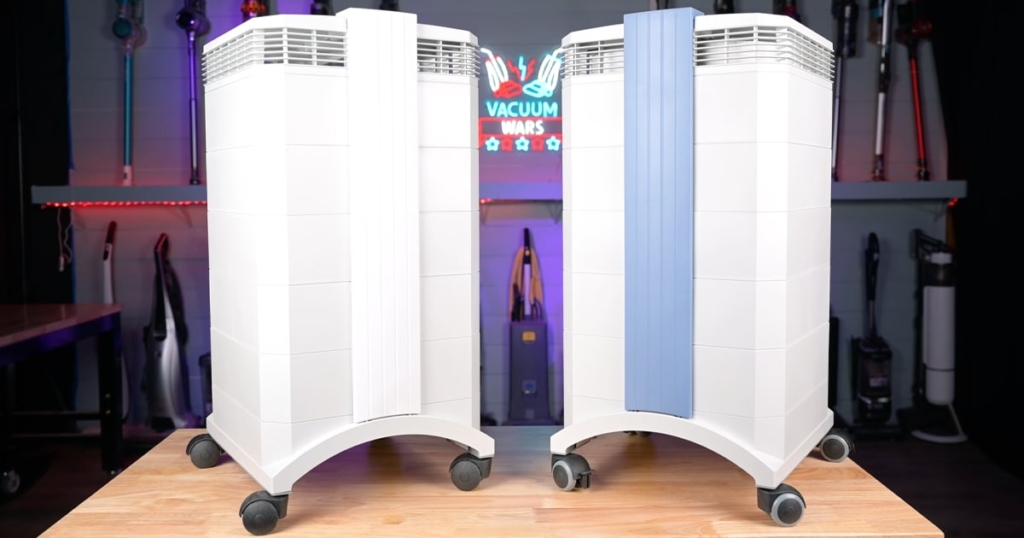Many consumers assume that all HEPA air filters and purifiers perform the same, but this is far from the truth. In reality, there are significant differences in quality, performance, and marketing claims across products labeled “HEPA.” Below, we explore in depth the issues raised by Air Purification Education (a consumer advocate in the air purification space) and fact-check his claims with independent sources. You’ll see why over 90% of “HEPA” air purifiers may not truly perform at HEPA levels, and what that means for you as a consumer.
Lack of Independent Testing or Standards for “HEPA” Claims
There is no regulatory body that verifies HEPA claims for household products. Surprisingly, manufacturers can call a filter “HEPA” without any third-party test to prove it. As the U.S. air purifier maker IQAir notes, “there is no requirement that household air purifiers are tested to meet HEPA standards” and “no independent body is required to test or verify the HEPA claim” [IQAir.com]. In practice, most so-called HEPA filters are never tested at all. The term “HEPA” (High Efficiency Particulate Air) technically means a filter that removes 99.97% of 0.3 micron particles (per U.S. DOE standard), but any company can use the word “HEPA” for marketing without proving it meets that standard [IQAir.com].
This lack of oversight creates a “Wild West” scenario in the industry. As Air Purification Education puts it, almost anyone could “strap a HEPA filter to a fan and market it as a HEPA air purifier even without significant third-party testing to back up the claim” [wikipedia.org]. No government agency or law regulates usage of the term “HEPA” on consumer air cleaners [IQAir.com]. This means consumers are largely on their own – unless you do your own testing or find reliable reviews, you can’t be sure a given “HEPA” purifier truly meets the standard.
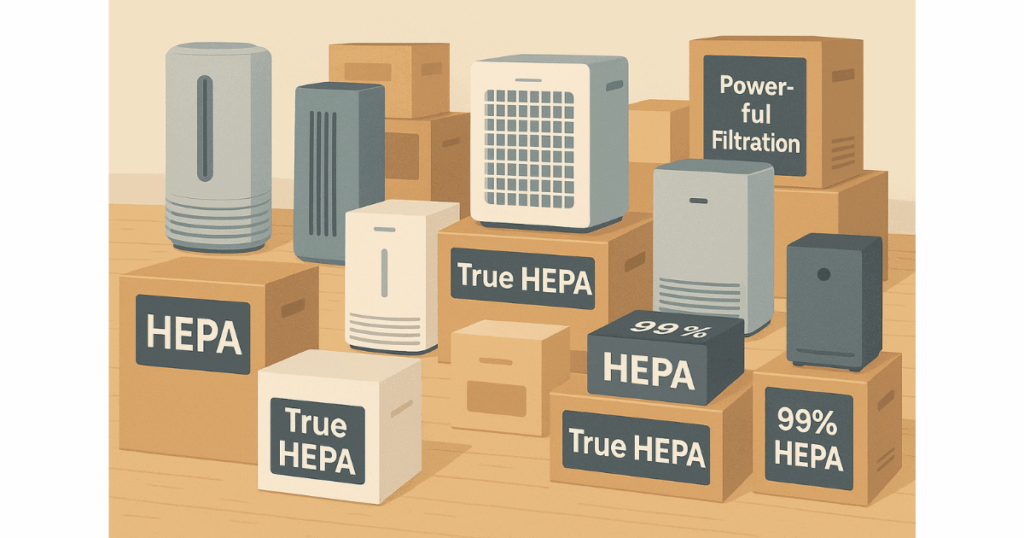
Misleading Marketing Terms: “True HEPA,” “HEPA-Type,” and More
Manufacturers have invented a confusing array of terms around HEPA. You might see filters sold as “True HEPA,” “HEPA-type,” “HEPA-like,” “HEPA-style,” or “99% HEPA.” These sound similar but are not the same as a genuine tested HEPA filter. In fact, products marketed as “HEPA-type,” “HEPA-like,” “HEPA-style” or “99% HEPA” do not satisfy the HEPA standard [wikipedia.org]. They often trap far fewer particles – sometimes only 90% or so – which is well below true HEPA performance [vacuumwars.com].
Even the term “True HEPA” is just marketing. Wikipedia confirms that “True HEPA” has no legal or scientific meaning. It’s used to assure buyers that the filter is real HEPA, but in reality this term isn’t regulated either. A manufacturer can label a filter “True HEPA” without any certification. As one source puts it: “True HEPA is a marketing term… although this term has no legal or scientific meaning.”
In other words, a “True HEPA” sticker is not a guarantee of performance.
“Many manufacturers use the term ‘HEPA’ to project a high-performance image onto their room air purifiers… The problem is there are no regulations regarding the use of ‘HEPA’ in testing and labeling products. In other words, no independent body is required to test or verify the HEPA claim. Thus, most so-called ‘HEPA’ filters are never tested!” – IQAir.com
The proliferation of these terms (HEPA-type, -like, -style, 99% HEPA) further confuses consumers [IQAir.com]. A filter labeled 99% HEPA, for example, means it was maybe tested to capture 99% of unspecified particles – which is far below the 99.97% @ 0.3 µm true HEPA benchmark. As IQAir explains, all these variants “are subpar versions of what truly constitutes a HEPA filter and may never have been tested”. Aside from doing your own measurements, there’s no way to know how efficient such filters really are [IQAir.com].
Bottom line: Don’t be misled by marketing jargon. A filter that actually meets HEPA standards will usually state 99.97% filtration at 0.3 microns, and sometimes list a class like H13 or H14 (more on those below). But even if it says that, because there’s no enforcement, you have to trust the manufacturer or look for independent test data.
Variations in HEPA Filter Materials and Build Quality
Even among filters that use HEPA-grade media, there are differences that affect performance. Not all HEPA media is equal. Traditional true HEPA filters are made of dense fibers of fiberglass or specialty synthetic fibers 10 . Some cheaper filters use ordinary coarse synthetic fibers instead. This results in a far less dense matrix that is less efficient at trapping fine particles [IQAir.com]. From the outside, you can’t easily tell the fiber quality, and companies rarely disclose it. But it means two filters both called “HEPA” could perform differently: one might truly stop 99.97% of micro-particles, while another using inferior fiber might let far more through.
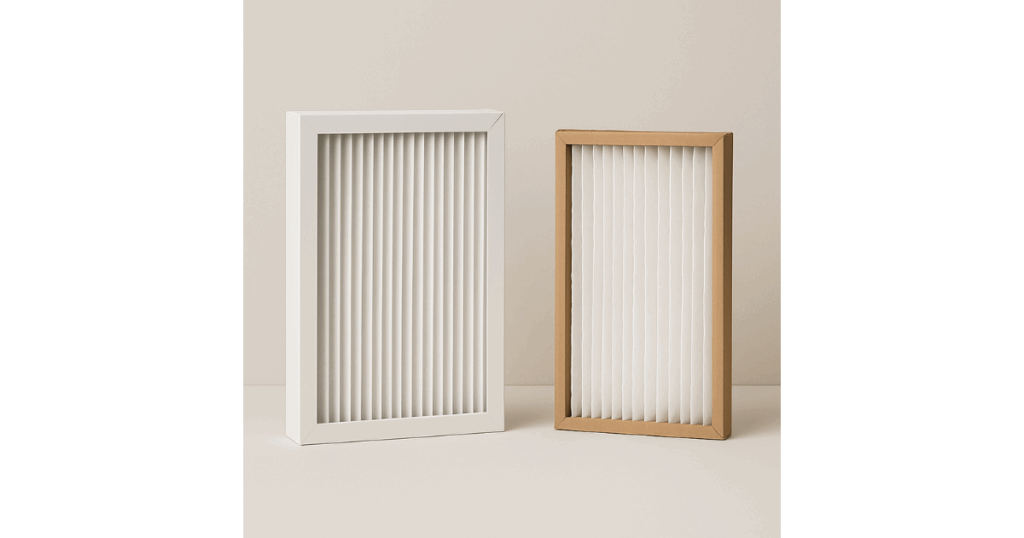
Additionally, HEPA filters are somewhat fragile, especially the ultra-fine fiberglass types. The pleated sheets can be damaged in manufacturing or shipping, creating tiny leaks or tears that aren’t visible. “There’s no guarantee a filter that passes HEPA standards will perform after manufacturing,” notes IQAir [IQAir.com]. A small bump or bend can create gaps for air to bypass or for particles to leak. Unfortunately, a consumer can’t detect internal damage just by looking. This means a filter that was perfect in the factory might not actually be HEPA-tight by the time you use it.
For example, the U.S. Department of Energy (DOE) – which uses HEPA filters in critical applications – found that even their high-grade filters had a significant failure rate after installation. In DOE tests, about 12% of installed HEPA filters failed leak testing (i.e. did not achieve full spec) despite being certified at manufacture [blog.gotopac.com]. These DOE filters have steel frames and are handled by professionals, yet one in eight still had leaks or defects [blog.gotopac.com]. The failures were due to things like handling damage, seal leaks, or media defects [blog.gotopac.com]. Now consider consumer air purifiers: they typically use cheaper construction (often cardboard frames) and are mass-produced and shipped all over. It’s reasonable to suspect at least 12% – if not more – of consumer HEPA filters aren’t performing to spec by the time you run them [blog.gotopac.com]. Small gaps or bending in a flimsy filter frame can allow unfiltered air to leak past the filter entirely, undermining performance.
Manufacturing quality control is another issue. Even reputable companies can have bad batches. The Air Purification Education video recounts how one premium brand, IQAir, admitted they once received a batch of carbon filter material that caused an odor problem – some customers noticed a sweet smell due to off-gassing, meaning the carbon was contaminated or pre-saturated. IQAir publicly acknowledged the mistake and replaced those filters. If a top-tier manufacturer with 50+ years experience can slip up, imagine the inconsistencies that might occur in budget brands (which may not be as forthcoming). Many budget filters are made in low-cost factories where oversight might be limited, and defects or variations (like the wrong fiber mix, poor adhesive, etc.) can happen unnoticed. Without testing every unit, such issues aren’t caught before they reach consumers [wikipedia.org].
In short, not every filter labeled “HEPA” is built to the same standard of material or care. Denser, high-quality media and sturdy construction cost more – that’s part of why genuine industrial HEPA filters are expensive. Cheaper units cut costs on media and build, and that can directly affect filtration efficiency and longevity.
The Importance of Proper Sealing in the Device
Even the best HEPA filter media won’t work if the filter isn’t sealed well in the purifier. A common, overlooked issue is air bypass – air taking the path of least resistance around the filter rather than through it. For a HEPA filter to do its job, all air must pass through the filter, with no gaps around the edges [wikipedia.org]. If the filter doesn’t fit tightly, or the gasket is poor, a significant portion of the airflow can leak around the filter, carrying dust straight past it.
A closer inspection of lower-end units often reveals flexible paper or cardboard filter frames and thin gaskets that can warp or leave gaps. These flaws allow unfiltered air to bypass the filter entirely. In some cases, dust can be seen accumulating on the clean side of the filter or inside the purifier housing—clear signs of air leakage. Even when the filter material is technically HEPA-grade, a poor frame design can prevent a proper seal, letting dirty air escape back into the room. Consumers who inspect their units may find dust coating areas that should remain clean, revealing that the unit isn’t providing true HEPA-level air purification.
This example illustrates a key point: the term “HEPA air purifier” only holds true if the filter integration is well-designed [teqoya.com] [wikipedia.org]. Unfortunately, many budget purifiers do not have robust sealing. Manufacturers often don’t talk about sealing quality, and there’s no standard requiring them to. As a consumer, you generally can’t see or test the seal without purchasing the unit and examining it. But it’s crucial: even a 99.99% media can perform far worse if air is bypassing it.
In fact, one source explains that air will find even the smallest gap to avoid a dense HEPA filter (which presents high resistance), so how the filter is mounted and sealed in the device is vital [tegoya.com]. If a unit’s design or construction is poor, you might get only a fraction of the expected filtration, especially as the filter gets dirty (making bypass even more likely). Always ensure your purifier’s filter is seated correctly; some devices have clamps or flush mounting to compress the seal. And be wary of very cheap units or “universal replacement filters” that may not fit perfectly. The best designs use thick gaskets and sturdy frames (often metal) to ensure a tight seal – something usually found in higher-end models or commercial units [tegoya.com].
Performance Drop Over Time: Clogging and Filter Loading
Most purifier tests and marketing focus on performance with a new, clean filter. But in real life, filters get dirty. As they capture particles, the HEPA media gradually clogs up. This not only reduces airflow but can also lower effective filtration efficiency. Over time, a dirty filter often lets more particles through (especially ultrafine ones) because air may start to channel through less-loaded sections or small leaks, and the overall airflow drops (so the purifier cleans less air per hour).
How big is this effect? Studies have measured it. In one cited study, after about 1500 hours of operation (roughly 2 months of continuous use), a HEPA air purifier’s ability to remove particles from a room dropped by 50% [tegoya.com]. In other words, its Clean Air Delivery Rate (CADR) was halved after a couple months of 24/7 use [tegoya.com]. That’s a dramatic decline – essentially the purifier was doing only half the job it did when new. The cause is filter loading and increased bypass: as dust packed into the filter, airflow was more restricted, creating pressure that likely forced some air around the filter (or through any tiny gaps) and reduced overall circulation [tegoya.com].
After 1500 hours (about two months) of continuous use, an air purifier’s efficiency in removing pollution was reduced by 50%, essentially cutting its CADR in half. [tegoya.com]
Another report from Germany found that with certain filters, the difference between a brand-new filter and one that had lost an initial electrostatic charge (discussed below) could mean a four-fold difference in effective clean air output [tegoya.com]. Even without electrets, any HEPA filter will eventually load up. As it does, two things happen: (1) it plugs the holes so airflow drops, and (2) the collected dust can potentially shed some particles or allow a bit of penetration if the fan is pulling hard. The net effect is a decrease in purification performance over time.
Manufacturers seldom publish any data on how their units perform after weeks or months of use – they usually tout only the like-new performance. But as a consumer, you should be aware that filter replacement schedules matter. If you wait too long to replace a HEPA filter, your purifier could be working at a much lower efficiency than advertised [wikipedia.org]. High-end systems sometimes include sensors or indicators based on pressure drop to tell you when a filter is loaded. For typical purifiers, a rough rule is replace HEPA filters every 6-12 months (or whatever the maker suggests) – and possibly sooner if running 24/7 or in dusty conditions.
The key point: A HEPA purifier’s real-world performance is a moving target – it’s highest with a fresh filter and will decline as the filter gets dirty. This is another reason not all “HEPA” purifiers are equal: some might start at 99.97% efficiency but fall to, say, 80% after a couple months, whereas a higher-quality unit (with a larger filter or better design) might maintain high efficiency longer before dropping.
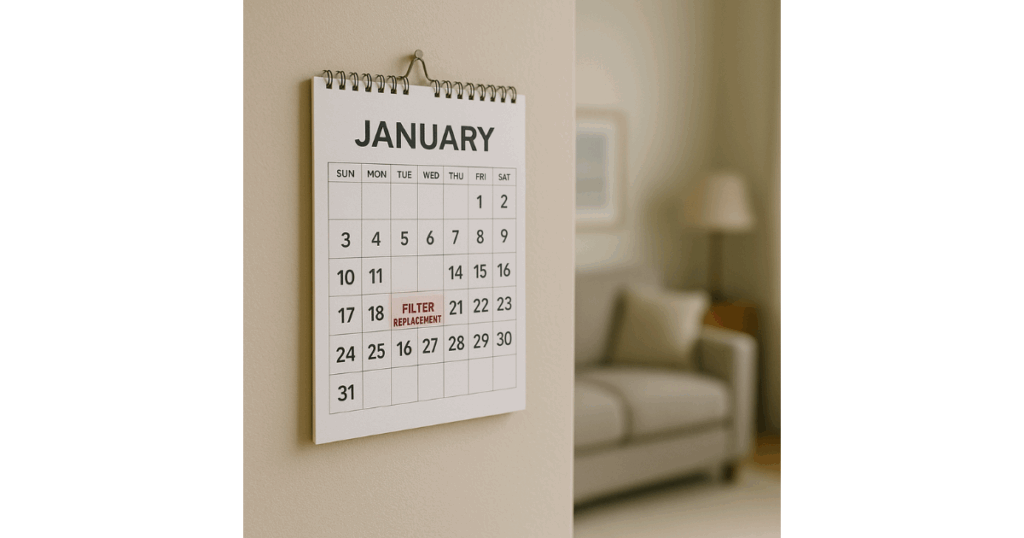
Shortcuts and “Hacks” in Certification Tests (Electret Filters)
We’ve discussed mechanical clogging, but there’s another trick some manufacturers use: electrostatic charge on the filter fibers. Certain HEPA filter media are treated to be electrets – basically imparting an electric charge to the fibers so they attract particles like a static magnet. This can significantly boost initial particle capture efficiency without increasing the density of the filter (which helps keep airflow resistance low). Sounds great, right? The catch is, these electrostatic charges tend to dissipate with use – the effect can vanish after hours or days as air flows through and neutralizes the charge [tegoya.com].
Why would companies do this? Because it can game the test results. For example, the strict EN 1822 European HEPA test measures efficiency on a new filter. A manufacturer can charge their filter media to ace the test at, say, 99.99% efficiency initially, thus earning an H13 or H14 label, even if the filter’s mechanical efficiency (uncharged) is much lower. Once the filter is in real use for a short time, that extra efficiency could drop away. A German study noted that some HEPA filters use electret treatments to test better in EN1822, but then lose a lot of efficiency in practice [tegoya.com]. They reported that when the electret effect wore off, the purifier’s efficiency dropped by a factor of four (i.e. 75% lower) compared to when new [tegoya.com].
In other words, a purifier could test like an H14 (99.995%) initially, but after a few days it might effectively perform like an E11 (95%) – a huge difference. This is essentially cheating, if done knowingly. The video narrator bluntly calls it “gaming the system” or, in plain terms, “cheating” when filter makers do this. Consumers would never realize it because the product might claim “H13 HEPA filter” based on that initial test, and it will still physically have the filter – it just won’t perform at that level for long in your home.
Interestingly, the EN1822 standard itself is robust, and H13/H14 filters are extremely good when truly meeting spec. The problem arises if a consumer device claims H13 or H14 but hasn’t been honestly tested in conditions reflecting actual use. Oransi (an American air purifier manufacturer) pointed out that some Chinese-made purifiers now advertise H13 or H14 filters, which is “quite aggressive” for a consumer unit [oransi.com]. Oransi explains that the filter media might be H13 grade in theory, but once pleated and put in a device, it’s likely only achieving E12 or E11 performance [oransi.com]. “Achieving an H14 level for a consumer air purifier is not believable… the pressure drop [would be too high] which lowers the CADR,” Oransi notes, casting doubt on those claims [oransi.com]. Essentially, if you actually had an H14 filter in a small purifier, the airflow would be so restricted that the device wouldn’t work well unless it was very powerful. So if a compact, quiet purifier advertises H14, be skeptical – it may either be false, or the filter has such high resistance that the purifier’s airflow is crippled (negating any benefit of higher filter efficiency).
The electret trick is one way such a claim might be propped up: the filter media tests at H14 with charge, but is much more porous mechanically (so airflow is okay). After some use, it no longer filters like H14 at all. This phenomenon also parallels what we discussed above: charged media and ionizers. In fact, the IQAir article warns that ionizer-based or electrostatic methods can show high initial efficiency but drop by up to 50% in a few months as plates get loaded or charges dissipate [IQAir.com].
For consumers, the takeaway is: beware of outlandish efficiency claims that aren’t backed by credible test data over time. A good question to ask is whether the purifier has any independent certification (like AHAM CADR ratings, or European test reports) and if those include long-term performance. Some companies might publish a one-time efficiency, but not mention how quickly it declines. If you see a spec like “removes 99.99% of 0.1 µm particles”, check if that’s an official standard or just marketing. As Oransi’s guide says bluntly: if you see efficiencies at particle sizes smaller than the standard test (0.3 µm in US or MPPS in EU), “it is marketing hype” [oransi.com].
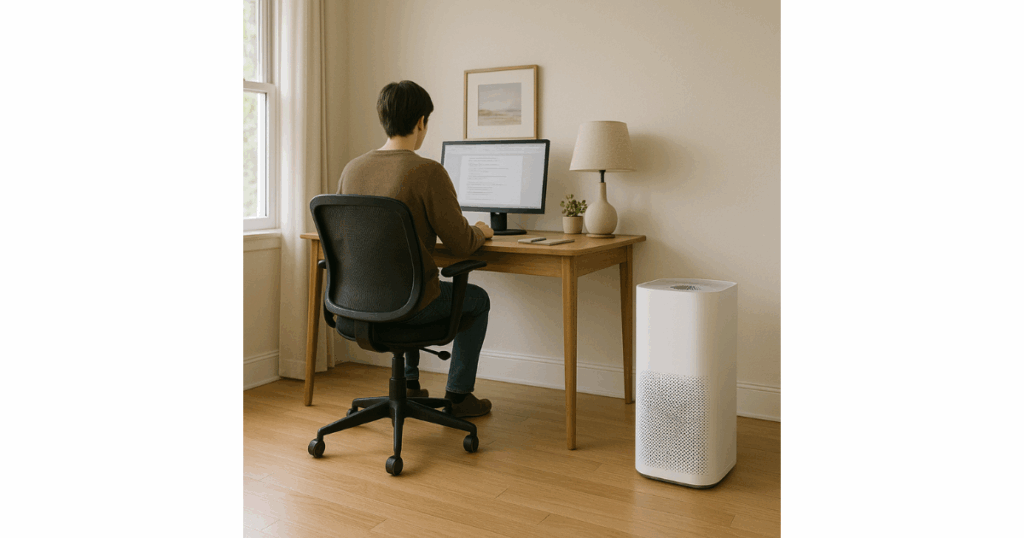
CADR vs. Actual Filtration Efficiency
Consumers often rely on CADR (Clean Air Delivery Rate) ratings to compare air purifiers. CADR is a measure of how much filtered air a purifier delivers, in cubic feet per minute, for specific particle size ranges (smoke, dust, pollen). It combines airflow and filtration efficiency into one number. A higher CADR means more cleaning power. However, CADR has its limitations, and some manufacturers “game” the CADR too in a way.
Because CADR rewards higher airflow, a purifier can score well with a moderately efficient filter and a strong fan. For example, an air cleaner with a slightly lower efficiency filter but double the airflow can achieve a high CADR – it’s moving a lot of air, even if not all is perfectly filtered. On the other hand, a unit with an ultra-dense filter but weak fan might have a lower CADR despite filtering a higher percentage on each pass. Some companies know that CADR is a key marketing point (especially in the U.S., where AHAM’s CADR is a recognized standard). So, they may design their purifiers to maximize CADR results – sometimes at the expense of using the absolute best filter.
As Air Purification Education explains, many brands will tout having a “medical grade HEPA filter” and a great CADR, but in reality they might be compromising the true HEPA performance to push more air [oransi.com] [oransi.com]. If they never actually test for actual filtration efficiency at 0.3 µm, the manufacturer can claim or imply HEPA, assume the filter media is close enough, and focus on the CADR numbers in marketing. The consumer sees “H13 filter” and “CADR 300” and assumes it’s both high-quality and powerful, when perhaps the device isn’t consistently achieving HEPA-level filtration in normal use.
It’s worth noting, CADR is still a useful metric – it ultimately tells you how fast the purifier can reduce particle levels in a room. Oransi’s blog argues that CADR (overall system performance) is what you should focus on as a consumer [oransi.com], since it accounts for both filter efficiency and airflow. But CADR is typically measured on a new unit in a lab. It doesn’t reveal if the unit maintains performance over time (a device with a high CADR that drops by 50% in two months would not be so impressive in the long run). Also, CADR tests are usually short – around 20 minutes – and don’t capture issues like filter loading or bypass developing over weeks.
The video host criticized CADR as a “flawed standard” in some ways, because a unit could have a great CADR in the lab but not truly deliver HEPA-level purification continuously in a home. For example, a unit that leaks or uses an electret filter might have a high initial CADR but then degrade. Unfortunately, consumers rarely get to see a “CADR after 6 months of use” figure.
The ideal is a purifier that has both high filter efficiency and sufficient airflow, and maintains it. Some high-end brands advertise not just CADR, but also that they individually test units for leakage or guarantee performance. Those are good signs. On the flip side, if a purifier’s specs seem to emphasize only fan power (CFM) and not much about the filter quality (beyond buzzwords), it might be a red flag that the filter isn’t actually as effective as implied.
In summary, CADR is important, but it’s not the whole story. A purifier needs a well-sealed, high-efficiency filter and a strong fan. Beware of devices that chase CADR at the cost of filtration, or vice versa. And remember CADR will drop as the filter loads up with dust – so a high CADR unit might only deliver that for a short period unless filters are replaced or cleaned frequently [oransi.com].
Evidence in Examples: Premium vs. Cheap Filters
To really drive home how not all “HEPA” filters are equal, let’s look at a tangible comparison done by the independent Air Purification Education channel on YouTube.
The video analysis compared five different HEPA filters side by side:
- An IQAir HealthPro Plus filter (a thick, 5-inch deep HEPA made in Switzerland, known for high quality control).
- An Aeris (iRobot) 3-in-1 filter (also a thick, heavy filter with HEPA + carbon, made in Switzerland).
- An Austin Air HealthMate filter (cylindrical HEPA with lots of activated carbon, handmade in USA by a reputable manufacturer).
- A Filter-Monster replacement filter (a third-party intended to fit Austin Air units).
- A Winix 5500-2 filter (a thin 1-inch filter with HEPA media for a popular budget purifier).
Visually and on paper, these are all “HEPA filters” for air cleaners – but their construction and presumably performance differ greatly.
For instance, the Austin Air OEM filter vs. the Filter-Monster generic copy: both fit the same purifier model. Many people assume a cheaper third-party filter is the same as the original. However, in this case, the copycat filter weighed about 7 pounds less than the genuine Austin filter (17.75 lbs vs 24.5 lbs). That’s a 39% weight difference, likely due to using less material (e.g. less carbon inside, lighter filter media, possibly thinner walls). Indeed, by peeking into the filter, the video showed that the Filter-Monster didn’t appear to be filled with carbon up to the top – there was a visible empty space at the top portion, whereas the authentic filter was filled with carbon granule media to the brim. This implies the knockoff has less activated carbon for gas/odor filtration. And because air will flow where resistance is lowest, air passing through that top section might skip carbon entirely (just going through a thin HEPA paper and out), meaning much less odor/VOC removal.
Additionally, the gasket and sealing on the two filters differed. The Austin filter uses a soft, thick gasket with an angled joint (mitered) for a tight seal, whereas the Filter-Monster had a smaller, harder gasket with a straight joint that already showed a slight gap [gotopac]. A softer, well-fitted gasket helps ensure no air leaks around the filter. The knockoff’s cheaper gasket could lead to leakage in the purifier, letting dust bypass the filter. These seemingly small differences (a bit of gap in the gasket, a bit less carbon, etc.) can have a big impact on performance – especially over time as the filter loads and the blower pushes harder (air will start leaking through any imperfect seal).
While we don’t have a third-party test comparing these two filters’ performance, the build quality clues strongly suggest the $170 clone filter would not perform as well as the $290 genuine filter. The old saying “you get what you pay for” likely applies. Cutting corners – be it less filter media, less sorbent, or cheaper sealing – tends to reduce effectiveness. The video host, after inspecting, said he would not trust the cheap replacement in his own Austin unit given the differences.
Finally, the Winix filter example underscores the contrast with the high-end filters. The Winix’s HEPA filter is very thin (about 1 inch) and has only a small amount of carbon coated on a pre-filter mesh. It’s also housed in a flimsy frame without robust sealing. After running it, the presence of dust on and around the filter proved that a lot of particulate was bypassing. This shows that just having “True HEPA filter” in the spec sheet doesn’t guarantee the device achieves true HEPA air cleaning. In this case, the Winix purifier would leak increasing amounts of dust as the filter clogged, meaning it never truly reaches 99.97% overall removal in the room. Compare that to, say, the IQAir or Aeris filters, which are thick, tightly sealed units – you generally won’t see dust leaking around those if used properly, and they maintain very high efficiency (IQAir even individually tests their units to ensure 99.97% at 0.3 µm from the device’s output).
The lesson for consumers: physical differences in filters (thickness, material, fit) matter a lot. When choosing an air purifier or replacement filter, consider the design. A larger, heavier filter usually has more surface area and often additional carbon for odors; it may last longer and maintain efficiency longer. High-end units often have gaskets, clamps, or other sealing mechanisms – look for those features. By contrast, very thin or lightweight filters may need replacing more often and might allow more bypass. And be cautious with off-brand replacement filters: some might work fine, but others could use subpar media or not fit as snugly, undermining your purifier’s performance. Without third-party test data, it’s hard to know, so weigh the cost savings versus the potential reduction in air cleaning performance.
A Note on iRobot’s $72 Million Air Purifier Acquisition
To further illustrate that not all “HEPA purifiers” are equal, consider this real-world business example:
In late 2021, iRobot (maker of Roomba robots) paid $72 million in cash to acquire Aeris Cleantec, a small Swiss company that makes premium air purifiers [techcrunch.com]. Aeris had only ~35 employees and was essentially a startup in the high-end purifier market. Why would a leading tech company spend so much on this niche player if “a HEPA filter and a fan” were all there is to an air purifier? The answer is technology and performance. Aeris’s products are known for actually achieving very high filtration (they even claim H14-level performance with thick multi-stage filters) and smart design. iRobot likely recognized that not all HEPA purifiers are the same, and that Aeris had design know-how or proprietary tech that sets it apart. If any random HEPA purifier was just as good, iRobot could have just slapped their own together. The fact they invested in an existing company implies that building a truly high-performance HEPA air purifier is not trivial. As the video narrator quipped, “if all HEPA filters were the same, iRobot wouldn’t have spent over $70 million to acquire an air purification company… those geniuses at iRobot could have just hooked up a couple of fans to some filters and done it themselves – but it’s not that simple, obviously” (paraphrasing his point).
This underscores that there are levels to quality and performance in this industry. Companies like IQAir, Austin Air, or Aeris differentiate themselves by engineering purifiers that consistently deliver true HEPA performance (even as filters load, even for ultrafine particles, even for whole-room circulation). They often use better materials, tighter quality control, and rigorous testing. Meanwhile, many mass-market purifiers are built to hit a price point and carry a “HEPA” label, but in practice they may not come close to those high standards, especially after some use.
Conclusions and Consumer Tips
HEPA filtration is the gold standard for particle removal – but only if implemented correctly. As we’ve seen, there are many pitfalls and variances that can make one “HEPA” air purifier function very differently from another. Here’s a summary of what to watch for as a consumer:
- Don’t trust the word “HEPA” blindly – There’s no enforcement behind it for consumer devices. Look for specifics: Does the manufacturer state an efficiency like 99.97% @ 0.3 µm? Do they mention standards like EN1822 (H13/H14) or DOE/IOST? If it just says “HEPA-type” or “HEPA-like,” assume it’s a lower efficiency filter.
- “True HEPA” isn’t a guarantee – It’s often just marketing. However, reputable brands that use the term usually at least intend to meet the 99.97% spec. Still, anyone can say “True HEPA,” so consider the brand’s credibility and whether they have test data.
- Consider build quality – Heavier, well-constructed filters (with metal or robust frames, and proper gaskets) are more likely to actually perform to spec and not leak [gotopac.com]. Cheaper filters with flimsy frames or no gasket might leak from day one. The filter housing in the device should hold the filter firmly.
- Beware cheap replacements – Off-brand filters can save money, but as we saw in the Austin vs Filter-Monster case, the differences in materials (like less carbon, different HEPA media, weaker seals) can be significant. If possible, read reviews or tests of third-party filters before using them in a high-end purifier, or stick to OEM filters if performance is critical.
- Performance over time – Remember that any filter’s performance will degrade as it gets dirty [tegoya.com]. Replace filters as recommended (or sooner if you have high pollution) to keep your purifier working effectively. If a unit has a pre-filter, clean it regularly; this prolongs the HEPA filter’s life by catching big dust. Some purifiers list a recommended runtime (e.g. 6 months at 8 hours a day) for the HEPA – use that as a guide.
- Electrostatic aids – If a purifier relies heavily on ionization or electrostatic charges (some products advertise “H13 filter plus plasma ionizer” etc.), be aware that initial efficiency might be high but could drop off. Also, ionizers can have side effects like emitting a bit of ozone or causing particles to stick to walls/furniture instead of the filter [IQAir.com]. Mechanical HEPA (without ionizers) is the safest bet for health [IQAir.com].
- CADR and room size – Use CADR as a guideline for how large a room a purifier can handle, but don’t assume two purifiers with the same CADR are equal in all ways. One might be loud and leaky, pushing a lot of air but not filtering it perfectly; another might quietly and truly filter more thoroughly but with a bit less airflow. Also, check if the CADR was certified by AHAM (an independent program) or just the company’s own number.
- Look for test info – Some high-quality brands will publish white papers or test results. For instance, IQAir claims their units are tested to ensure actual air coming out is 99.97% clean [IQAir.com]. If a company provides proof or standards compliance, that’s a good sign. On the other hand, if all you see are vague claims (“hospital-grade air!”) with no data, stay skeptical.
- Be mindful of VOC/odor needs – If you care about odors or chemical fumes, the amount of activated carbon in a purifier matters. As seen, a filter not fully filled with carbon will be less effective for gases. Weight can be a clue: purifiers that adsorb odors often have several pounds of carbon (the Austin filter weighed a lot in part due to 15 lbs of carbon). A lightweight filter likely has minimal carbon, even if it mentions it.
In conclusion, HEPA technology is powerful, but only when done right. Many products exploit the term “HEPA” for marketing without delivering the true benefits. By understanding the nuances – from lack of testing standards, to filter media differences, to the critical importance of design and maintenance – you can make better decisions and avoid falling for misleading claims. If you want the cleanest air, do a bit of homework on the purifier’s engineering, and remember that a higher upfront cost for a well-built unit (or filter) can pay off in actually giving you the clean air you’re expecting. When it comes to air purifiers, you often get what you pay for: sometimes that budget “HEPA” unit just isn’t in the same league as a properly engineered one [gotopac.com].
Stay informed, and breathe easy knowing you’ve chosen wisely!
